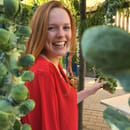It’s autumn in the northern hemisphere, and bright orange is exploding everywhere you look.
Fiery foliage drapes the trees, squash decorates tabletops, and, most notably, pumpkins are popping up in every direction – even in coffee. If you live anywhere in the United States, it’s difficult to ignore the barrage of seasonal pumpkin products. Especially during the last fifteen years, pumpkin – specifically pumpkin spice – has exploded in popularity, becoming the quintessential (and perhaps most overused) flavor of fall. You may be surprised to learn what constitutes this familiar flavor, as well as the story behind it, stretching from the earliest European settlers of America to the PSL of today.
Humble Beginnings
In colonial America, pumpkins were easy to come by but played a different role in society than they do today. The pumpkin was introduced to the colonists by Native Americans and incorporated into the colonial diet out of need for a hardy food source that could last through the winter. Mixtures of spices imported from the east, such as cinnamon, nutmeg, ginger, and allspice, were important in preparation for the change in seasons – flavoring baked goods and preserving foods to store all winter long. Such spices had already been used for centuries to flavor dishes that marked celebratory occasions in other cultures, like Masala Chai in India and Baklava in the Middle East. The colonists probably didn’t eat sweet spiced pumpkin desserts as we do today. They most likely consumed the squash in savory soups or as a substitute for other vegetables and condiments.
Separating the Pumpkin and the Spice
The first known pumpkin recipe in American cookbooks is from 1796. A recipe for pompkin flavors the squash with milk, eggs, molasses, allspice and ginger. The pumpkin shook off its humble reputation in the 19th century when it became a romanticized symbol of farm and country life. The squash was marketed as a comfort food, and the popularity of pumpkin pie
began to rise.
In the 1950s and 1960s, the spice company McCormick began selling a packaged mixture of cinnamon, ginger, nutmeg, and allspice marketed as “Pumpkin Pie Spice.” This was the moment when pumpkin spice became its own entity, separate from the orange squash whose name it bears.
Pumpkin Spice Today
You may know that most of today’s pumpkin spice products don’t actually contain pumpkin, but did you know that many don’t even contain real spices? Food manufacturers often develop synthetic chemical versions of the classic spice mixture that trick your brain into thinking you consumed those spices. Why is it that these synthetic spices are so satisfying? It all harkens back to the pilgrim days. Like clockwork, the arrival of the pumpkin spice flavor every year is a pattern our brains learn to rely on and expect. This occurrence, along with the fun holidays of the season, create a positive odor association that automatically links the smell, taste, and even thought of pumpkin spice to positive experiences. Just like warming spices helped colonists prepare for the change of seasons, the familiar aroma of the pumpkin spice mixture triggers a sense of preparation for the holiday season, evoking feelings of warmth, family, and comfort. And of course, our free market has capitalized on this phenomenon by saturating stores with so much pumpkin spice that it’s inescapable from August to November.
So, if you find yourself inexplicably craving one of those disarmingly orange pumpkin coffee drinks, or impulse buying a pumpkin candle in the checkout line at Target, you can blame history, capitalism or your brain chemistry!


